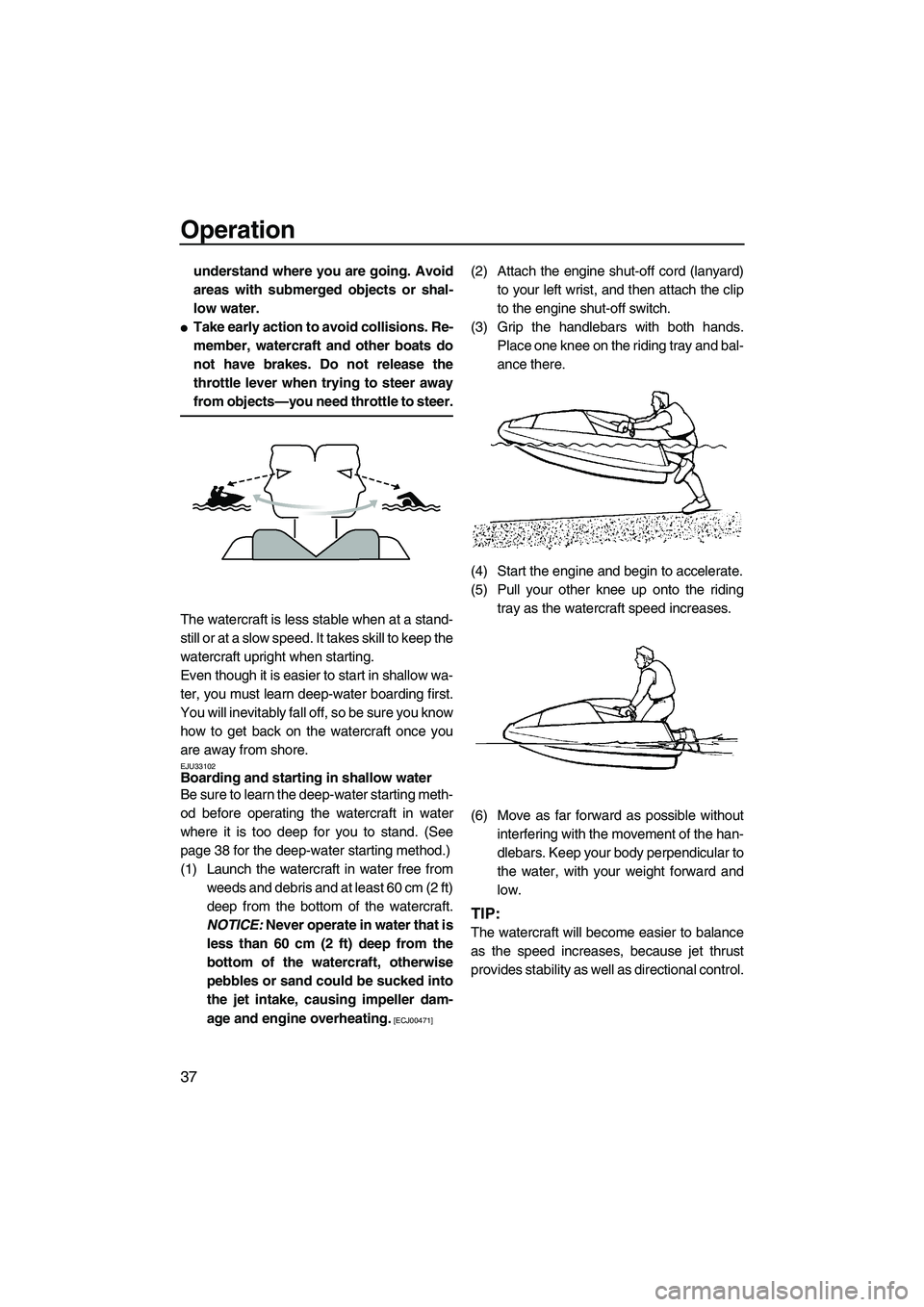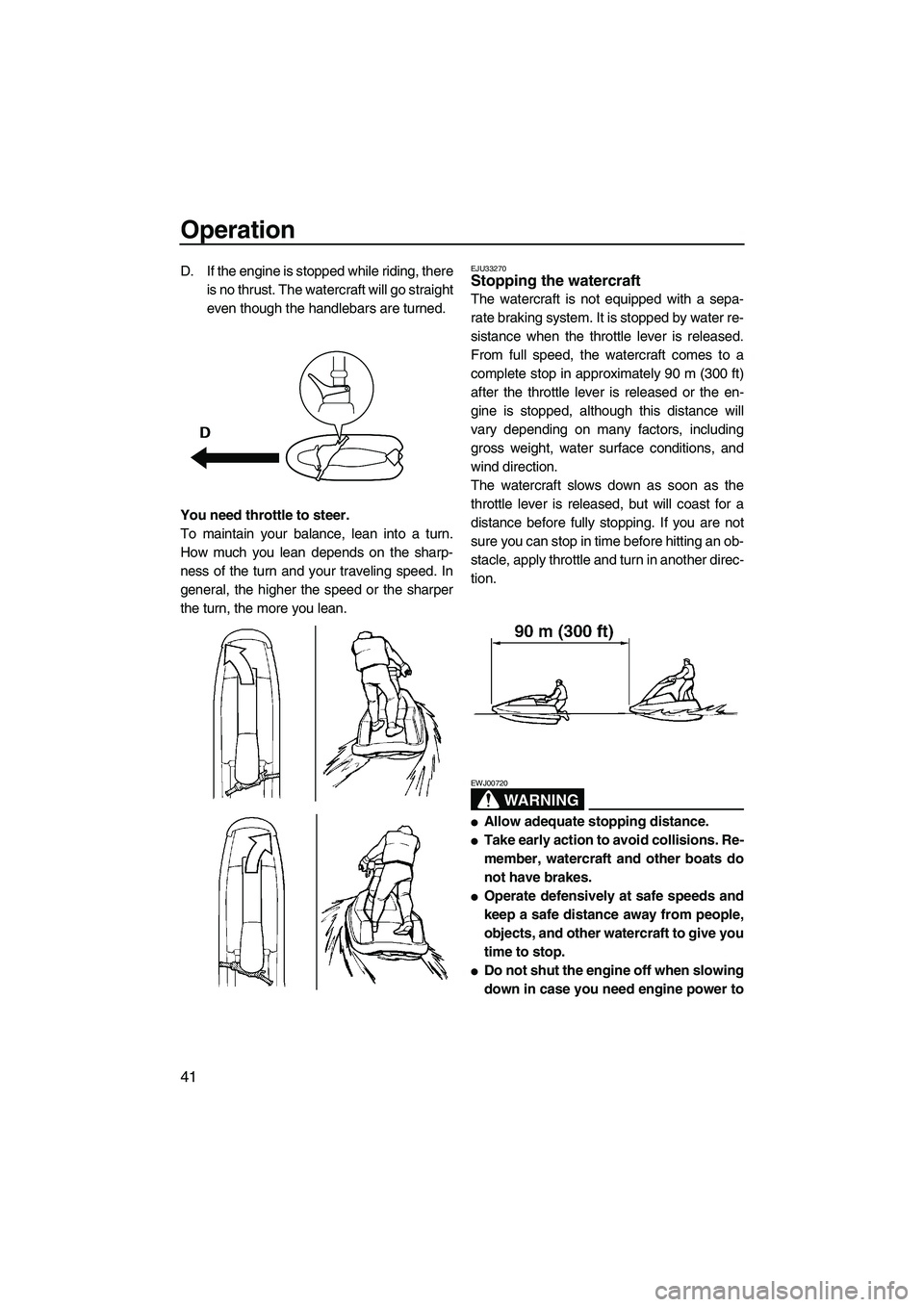Page 15 of 76

Safety information
8
EJU30761
Cruising limitations
�Scan constantly for people, objects, and
other watercraft. Be alert for conditions that
limit your visibility or block your vision of
others.
�Operate defensively at safe speeds and
keep a safe distance away from people, ob-
jects, and other watercraft.
�Do not follow directly behind watercraft or
other boats.
�Do not go near others to spray or splash
them with water.
�Avoid sharp turns or other maneuvers that
make it hard for others to avoid you or un-
derstand where you are going.
�Avoid areas with submerged objects or
shallow water.
�Take early action to avoid collisions. Re-
member, watercraft and other boats do not
have brakes.
�Do not release the throttle lever when trying
to steer away from objects—you need throt-
tle to steer. Always check throttle and steer-
ing controls before starting the watercraft.
�Ride within your limits and avoid aggressive
maneuvers to reduce the risk of loss of con-
trol, ejection, and collision.
�This is a high performance boat—not a toy.
Sharp turns or jumping wakes or waves can
increase the risk of back/spinal injury (pa-
ralysis), facial injuries, and broken legs, an-kles, and other bones. Do not jump wakes
or waves.
�Do not operate the watercraft in rough wa-
ter, bad weather, or when visibility is poor;
this may lead to an accident causing injury
or death. Be alert to the possibility of ad-
verse weather. Take note of weather fore-
casts and the prevailing weather conditions
before setting out on your watercraft.
�As with any water sport, you should not op-
erate your watercraft without someone else
nearby. If you operate further than swim-
ming distance from shore, you should be
accompanied by another boat or watercraft,
but make sure you stay a safe distance
away. It’s good, common sense.
�Never operate in water that is less than 60
cm (2 ft) deep from the bottom of the water-
craft, otherwise you increase your chance
of hitting a submerged object, which could
result in injury.
�This watercraft is not equipped with lighting
required for night operation. Do not operate
the watercraft after sunset or before dawn,
otherwise you increase the risk of colliding
UF2F71E0.book Page 8 Thursday, April 10, 2008 11:47 AM
Page 44 of 76

Operation
37
understand where you are going. Avoid
areas with submerged objects or shal-
low water.
�Take early action to avoid collisions. Re-
member, watercraft and other boats do
not have brakes. Do not release the
throttle lever when trying to steer away
from objects—you need throttle to steer.
The watercraft is less stable when at a stand-
still or at a slow speed. It takes skill to keep the
watercraft upright when starting.
Even though it is easier to start in shallow wa-
ter, you must learn deep-water boarding first.
You will inevitably fall off, so be sure you know
how to get back on the watercraft once you
are away from shore.
EJU33102Boarding and starting in shallow water
Be sure to learn the deep-water starting meth-
od before operating the watercraft in water
where it is too deep for you to stand. (See
page 38 for the deep-water starting method.)
(1) Launch the watercraft in water free from
weeds and debris and at least 60 cm (2 ft)
deep from the bottom of the watercraft.
NOTICE: Never operate in water that is
less than 60 cm (2 ft) deep from the
bottom of the watercraft, otherwise
pebbles or sand could be sucked into
the jet intake, causing impeller dam-
age and engine overheating.
[ECJ00471]
(2) Attach the engine shut-off cord (lanyard)
to your left wrist, and then attach the clip
to the engine shut-off switch.
(3) Grip the handlebars with both hands.
Place one knee on the riding tray and bal-
ance there.
(4) Start the engine and begin to accelerate.
(5) Pull your other knee up onto the riding
tray as the watercraft speed increases.
(6) Move as far forward as possible without
interfering with the movement of the han-
dlebars. Keep your body perpendicular to
the water, with your weight forward and
low.
TIP:
The watercraft will become easier to balance
as the speed increases, because jet thrust
provides stability as well as directional control.
UF2F71E0.book Page 37 Thursday, April 10, 2008 11:47 AM
Page 48 of 76

Operation
41
D. If the engine is stopped while riding, there
is no thrust. The watercraft will go straight
even though the handlebars are turned.
You need throttle to steer.
To maintain your balance, lean into a turn.
How much you lean depends on the sharp-
ness of the turn and your traveling speed. In
general, the higher the speed or the sharper
the turn, the more you lean.EJU33270Stopping the watercraft
The watercraft is not equipped with a sepa-
rate braking system. It is stopped by water re-
sistance when the throttle lever is released.
From full speed, the watercraft comes to a
complete stop in approximately 90 m (300 ft)
after the throttle lever is released or the en-
gine is stopped, although this distance will
vary depending on many factors, including
gross weight, water surface conditions, and
wind direction.
The watercraft slows down as soon as the
throttle lever is released, but will coast for a
distance before fully stopping. If you are not
sure you can stop in time before hitting an ob-
stacle, apply throttle and turn in another direc-
tion.
WARNING
EWJ00720
�Allow adequate stopping distance.
�Take early action to avoid collisions. Re-
member, watercraft and other boats do
not have brakes.
�Operate defensively at safe speeds and
keep a safe distance away from people,
objects, and other watercraft to give you
time to stop.
�Do not shut the engine off when slowing
down in case you need engine power to
UF2F71E0.book Page 41 Thursday, April 10, 2008 11:47 AM